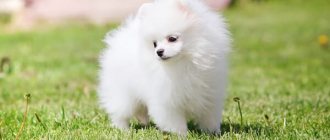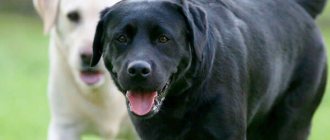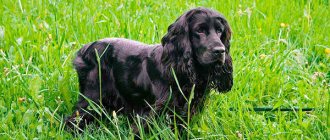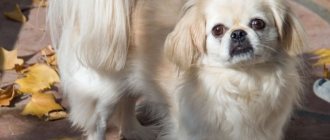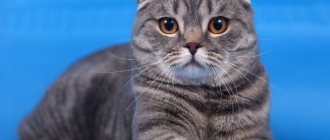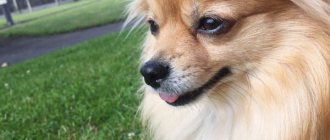Pomeranians with black coats look elegant and, at the same time, a little funny.
This color is considered one of the most ancient and classic, however, currently it is not as popular as brighter orange or, for example, cream.
The Black Pomeranian is suitable not only for connoisseurs of the classics, but also for anyone who wants a cute and playful dog with a rather rare and unusual color for this breed to live in his home.
But future owners of these dogs need to know about their breed characteristics and how to care for such a pet.
History of appearance
The history of Spitz breeds goes back more than one century. At first, these were quite large dogs, whose distinctive features were a pointed muzzle, triangular erect ears and a fluffy tail curled into a ring, as well as thick and warm two-layer fur that protected them from cold and precipitation.
It is impossible to determine exactly when this or that color appeared in the breed, however, black Spitz have existed for centuries.
Around the 15th century, such dogs with jet-black fur were already bred in the territory of modern Württemberg, where they were mainly used to guard vineyards. In those days, people preferred to keep the largest Spitz dogs, and this breed itself was considered a peasant breed, not a boudoir breed.
The nobility paid attention to the Spitz only in the 18th century. And so, in 1767, Spitz came to England, where they very quickly became a fashionable salon breed.
A significant role in this was played by the fact that the first two Spitz dogs were brought to Britain by Queen Charlotte, who became the wife of King George III and did a lot to popularize these dogs. Queen Victoria, who was her granddaughter, was fond of dog breeding and in her personal kennel the main breeding work was carried out to miniaturize this breed.
NOTE!
Victoria wanted to get really small Spitz dogs and she managed to achieve her plan. By the end of her reign, the size of these dogs was no longer 14-23 kg, as before, but 5-7 kg.
In England, the first breed club was founded in 1891, and soon the first standard appeared. In 1998, the ICF recognized the Pomeranian Spitz not as a separate breed, but as a size variety of the German Spitz, and it was included in the new standard under the name “miniature”.
What is assessed in dogs according to the standard?
The Pomeranian Spitz evokes admiration for its grace, beauty of coat and very thick undercoat. The little dog looks like a real lion. By all standards, even the smallest details of skeletal structure, gait, posture and even shades of fur are subject to assessment. The dog should be energetic, cheerful and cheerful. The Spitz breed standard includes a lot of nuances and criteria.
Pomeranian size
The main thing in the Pomeranian Spitz is the proportionality of the body structure, the bearish appearance and the classic type of structure. The length of the body should be equal to the height at the withers of the dog. At the same time, the height limit for a pet is 22 cm, and the minimum height of an adult dog is 18 cm. Fluctuations of no more than two centimeters are allowed. A small Spitz, whose size is small, almost always passes into the standards.
The maximum weight of the breed is 3 kg, but this applies more to girls, boys are somewhat lighter, as a rule. Do not exceed the norm of 2.3 kg. The minimum permissible weight is 1.8 kg for an adult dog. At the same time, the physique of the pets is quite strong, the legs and body are dense and knitted.
Not only parameters are taken into account, but also appearance
Head
The wedge-shaped head tapers somewhat toward the nose. Which should be black. The exception is brown puppies; their noses are also brown. The nose is not too long in relation to the skull.
For reference! A proper Pomeranian has a nose to head ratio of 2:4.
The dog's lips are the same shade as his nose. They have no folds. Smooth, tightly fitting to the teeth.
The dog has a total of 42 teeth, a scissor bite of the jaw, but a pincer bite is also allowed.
- All teeth are vertical.
- The cheekbones are not highlighted, the cheeks are rounded.
- The eyes are medium. Slightly almond-shaped, located close to each other.
- The color of the eyes directly depends on the shade of the nose.
- The ears are short, close, erect, and pointed at the tips.
Torso
The neck is not long, wide, fluffy hair forms a beautiful fluffy collar. The small withers immediately extend into the back.
The back is straight, wide, short, like the lower back - strong. The fluffy tail forms a ring and partially covers the back. The standard croup is not sloping, short, wide.
The stomach is tucked, the chest is directed deep back. The tail is medium in size, formed high. It lies close to the back and has a thick coat. The end of the tail can be twisted into a double ring.
Spitz color is important
Limbs
Wide-set, strong front and hind legs characterize the true Pomeranian. All limbs have dense muscles. The shoulder is the same size as the shoulder blade, and they are located at an angle of 90 degrees.
The elbow is located close to the chest, not turned out, directed straight. The forearm is medium-sized and straight in relation to the body. The pastern is at an angle of 20 degrees and is of medium size. The dimensions of the thigh and lower leg are approximate. The knees are moderately expressed and do not turn out when walking. The skin of the Pomeranian does not create folds on the body. Stretch tight.
The front paws have toes pressed tightly together when black or dark brown. The hind limbs are muscular, have thick hair, which is located on the hock joints. The paws are parallel and straight. The pads on the limbs are full.
Marriage or breed?
Black and black and tan colors are considered standard for Pomeranians.
Expert opinion
Kozhevin Semyon Kirillovich
Expert dog handler.
“The black color of Spitz dogs looks quite unusual and original. But breeding pure black representatives of this breed is associated with one very interesting nuance: all the puppy’s ancestors must be black, otherwise the color may turn black and tan as it grows up, or foreign shades will appear in it. For this reason, it is not very common to meet true black Pomeranians. However, it is wrong to think that black Spitz dogs must be only one color. After all, in addition to pure black, the standard also recognizes the black and tan color, in which bright reddish-fawn markings are located on the main background, giving the dogs a less severe appearance.”
Character traits
Black Pomeranians, despite their small size, do not consider themselves small dogs at all.
They are brave enough to fight back another, larger dog and, obviously, following the instincts of their ancestors, they will not miss the opportunity to bark at a stranger who finds themselves on their territory. At the same time, a Black Pomeranian can easily get along in the same house even with a cat, not to mention another dog.
Black Pomeranians love to run and play and are very energetic and active. These dogs are characterized by an affectionate and devoted character, they are smart and quick-witted. But if you raise such a pet incorrectly, it can become selfish and, at times, aggressive.
IMPORTANT!
Black Pomeranians make good companions for children, but you should not buy these dogs as a gift for children under 8-10 years old.
Training
Black Pomeranians are very intelligent and easy to train. There is no need to use strict methods; it is usually enough to say it once to achieve the desired effect. Spitz dogs love to surprise their owners with various touching “numbers”. Working with the Spitz's voice will be a good bonus for you: these dogs are very easily excited and accompany events with a long, loud, barking sound.
Advantages and disadvantages
Pros:
- Beautiful, sweet and funny at the same time.
- They have an active and energetic disposition.
- Black Pomeranians are great for apartment living.
- They easily learn to use a diaper.
- They get along with other pets.
- They treat children well.
- They are not demanding in terms of feeding: they can eat both ready-made food and home-cooked natural food.
- The small size of such a pet allows owners to take it with them on any trip.
- They are distinguished by good health and live long.
Minuses:
- They are quite noisy and love to bark, especially when left alone.
- They do not hesitate to get involved in conflicts with other people's dogs.
- They do not always consider it necessary to follow the owner’s commands.
- Caring for their coat requires some effort.
- The high cost of puppies makes Black Pomeranians “not a dog for everyone.”
- Black Pomeranians are highly emotional.
- Not the easiest breed to breed: there are few puppies in a litter, and, moreover, when breeding pure black Spitz, you need to take into account the peculiarities of color genetics.
NOTE!
Black Pomeranians shed very strongly - twice a year they change first the undercoat, and then the coat, which complicates their care and significantly increases the amount of wool in the house.
Cream Pomeranian
© shutterstock
The Cream Spitz is a beautiful dog with light fur. This cream-colored dog is often born white, but after a few months its coat darkens to cream.
One of the genes involved in creating the cream color is the E Locus gene, which also gives the red Pomeranian color.
This color variety requires careful grooming as their fur shows up easily on clothing.
Photos of color options
Black
According to the standard, only pure black coat color is acceptable, without the slightest inclusion of white hairs. Moreover, this applies to both the guard hair and the undercoat.
However, getting a jet black color is only possible if all of the puppy's ancestors were black. If this feature is not taken into account, then two black standard dogs may produce puppies with a lighter undercoat or with a brownish or reddish tint to the coat.
Brownish tints may appear on the undercoat even before the start of the next shedding. When the Pomeranian sheds its coat, its fur will again become as black and thick as before.
Black and Tan
Black and tan color is when the main black color of the coat has tan marks of a reddish or golden hue.
At the same time, representatives of the black and tan color should have tan marks in the following places:
- On the inside of the ears.
- Above the eyes.
- On the muzzle and lower jaw.
- On the neck.
- On the chest.
- On the paws.
- Under the tail.
Black and white
Unlike the two listed above, this color is outside the standard. With it, on a black background there are small white spots of various shapes, the total area of which does not exceed 50%.
Tricolor
This coat color, in which the black and tan coloring is complemented by small white markings, is also considered non-standard. Tricolor Pomeranians are not allowed for exhibitions or breeding.
Wool quality
Primitive northern dogs gave the Spitz a practical and unpretentious coat. The outer hair is called guard hair; it protects the Pomeranian from moisture, dirt, sunlight and physical damage. The outer coat is straight, shiny, and hard.
The undercoat is the fine, soft hair that lies beneath the coarse outer hair. Thick and dense, it protects the dog from overheating in summer and hypothermia in winter.
The Pomeranian Spitz has distinctive features of its appearance:
- Elongated, lush coat - a “collar” around the head;
- A fluffy “hat” on the head;
- Long hair on cheekbones;
- Itching on the back of the limbs;
- Long hair covering the tail;
Incorrect structure:
- Curly, wavy coat;
- Soft guard hair;
Life expectancy and what diseases are they susceptible to?
Black Pomeranians live 12-16 years on average.
Despite their small size, these dogs are considered a completely healthy breed, but some of its representatives may be susceptible to the following ailments:
- Diseases of the teeth and oral cavity
- Atlantoaccipital subluxation
- Tracheal collapse
- Turn of the century
- Hypothyroidism
- Sick sinus syndrome
- Patella luxation
- Cataract
- Retinal atrophy
- Complicated childbirth
- Cryptorchidism.
- Obesity
IMPORTANT!
Like many other toy dog breeds, Black Pomeranians are prone to dental disease and early tooth loss.
Basic rules of care
The coat of the Black Pomeranian Spitz does not require complex care. It is enough to brush your pet once every few days with a not too hard brush.
But during molting, this procedure should become more frequent - at least daily. It is better to comb the orange 2-3 times a day, while trying to remove as many fallen hairs as possible.
Dogs of this breed are washed as needed: as a rule, before shows, after shedding, and if the Spitz is so dirty that bathing with shampoo is indispensable. The rest of the time, if the dog, for example, took a walk in the rain, it is enough to wash the contaminated areas with regular warm water without using soap.
If desired, if the pet does not participate in exhibitions, it can be cut, first choosing one of the many hairstyles. This will not only make it easier to care for its coat, but will also give the Spitz a special, unique look.
The ears, eyes and mouth of the black orange should be inspected every day and, if necessary, cleaned. To clean the ears, you can use cotton swabs, after dipping them in a special solution purchased at a veterinary pharmacy.
The eyes are cleaned with a cotton swab or disk soaked in the composition for cleaning them.
Spitz teeth require special control. They need to be regularly inspected and cleaned, and if signs of inflammation appear or hard plaque has formed, you should contact a veterinary clinic.
It is recommended to trim the claws with a nail clipper every two or three weeks. Considering that all dogs have different claws in strength, you need to proceed from the individual characteristics of the pet.
NOTE!
If the claws begin to knock loudly on the floor when your pet moves, or their ends begin to bend inward, then they need to be trimmed.
Interesting Facts
Initially, the Spitz dog was not miniature. Spitz dogs lived with poor people and helped guard flocks of sheep. Only a century later, such pets began to appear among wealthy citizens.
Spitz resembles foxes or bear cubs
Newton also had a Pomeranian dog named Diamond. She was entertaining her master and one day she dropped a burning candle from the table. The flame spread to the manuscripts and destroyed the papers. Newton did not scold his pet.
The Pomeranian is a very smart and easy to train dog. Perhaps this is why the breed was repeatedly mentioned in various classical works, for example, in “The Legend of Ulenspiegel” and “The Lady with the Dog”.
Important! People called them “little Napoleon” because of their decisive character. Pomeranian dog for active people
Pets can be found among Hollywood stars - Mickey Rourke, Sylvester Stallone and others. It is known that during the rescue of the Titanic, three dogs were rescued - two of them were Spitz breeds
Pomeranian is a dog for active people. Pets can be found among Hollywood stars - Mickey Rourke, Sylvester Stallone and others. It is known that during the rescue of the Titanic, three dogs were rescued - two of them were Spitz breeds.
Small dogs have gained popularity in many countries around the world. They can be found in the USA, Canada, Czech Republic, France and other places. Historians suggest that the first representatives of the breed lived during the time of the pharaohs.
How to choose a puppy?
You need to buy a black Pomeranian Spitz only with documents of origin and, preferably, in a good nursery.
It would also be a good idea to contact a kennel club to tell them which private breeders currently have puppies for sale.
When going to choose a pet, you need to pay attention to how well-groomed and healthy the puppies look, as well as other dogs in the kennel.
A small Pomeranian Spitz should be similar in proportions to an adult representative of the breed - it has a body format close to square, small ears and a short, slightly pointed muzzle .
Before buying a pure black dog, you need to carefully study the pedigree of the puppy’s parents to make sure that at least those of the baby’s ancestors listed there have black coat color.
Regarding black and tan Spitz, it should be noted that this color is clearly visible even in the smallest puppies. But it is desirable that the scorch marks be as bright and contrasting as possible and located in the places specified in the standard.
As for the black-and-white and tricolor Pomeranian puppies, no matter how cute these babies look, you need to remember that these colors are considered a breeding match. The nursery must issue a certificate for such a Spitz, but it must include a note about the breeding.
